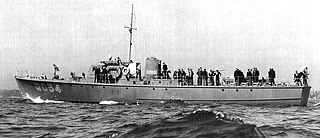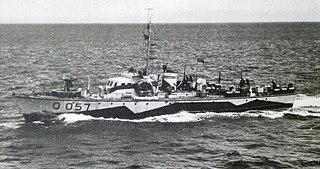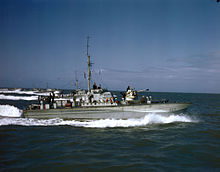
A motor torpedo boat is a fast torpedo boat, especially of the mid 20th century. The motor in the designation originally referred to their use of petrol engines, typically marinised aircraft engines or their derivatives, which distinguished them from other naval craft of the era, including other torpedo boats, that used steam turbines or reciprocating steam engines. Later, diesel-powered torpedo boats appeared, in turn or retroactively referred to as "motor torpedo boats" for their internal combustion engines, as distinct from steam powered reciprocating or turbine propulsion.

The motor gunboat (MGB) was a small, high-speed British military vessel of the Second World War, which was armed with a mix of guns, in contrast to the physically similar motor torpedo boat (MTB), whose main offensive weapon were torpedoes. The small size of the MGBs, and their high speed, made them difficult targets for German E-boats, though, like their opponents, they were limited by heavy weather, because they did not provide a stable-enough platform to aim the guns. The large number of guns meant the crew was relatively large, numbering as high as thirty men on the largest boats.

The Norwegian armed forces in exile were remnants of the armed forces of Norway that continued to fight the Axis powers from Allied countries, such as Britain and Canada, after they had escaped the German conquest of Norway during World War II.

The Fairmile B motor launch was a very numerous class of motor launch produced in kit form by British boatbuilder Fairmile Marine, and then assembled and fitted out by numerous boatyards during the Second World War to meet the Royal Navy's coastal operation requirements.

The Fairmile D motor torpedo boat was a type of British motor torpedo boat (MTB) and motor gunboat (MGB), conceived by entrepreneur Noel Macklin of Fairmile Marine and designed by naval architect Bill Holt for the Royal Navy. Nicknamed "Dog Boats", they were designed to be assembled in kit form mass-produced by the Fairmile organisation and assembled at dozens of small boatbuilding yards around Britain, to combat the known advantages of the German E-boats over previous British coastal craft designs. At 115 feet in length, they were bigger than earlier MTB or motor gunboat (MGB) designs but slower, at 30 knots compared to 40 knots.

Coastal Forces was a division of the Royal Navy initially established during World War I, and then again in World War II under the command of Rear-Admiral, Coastal Forces. It remained active until the last minesweepers to wear the "HM Coastal Forces" cap tally were taken out of reserve in 1968. The division received more gallantry awards than any other branch of the Royal Navy during that period.

The Coastal Forces of the Royal Canadian Navy (RCN) was a specialized naval force of well-armed, small and fast motor launch (ML) and motor torpedo boat (MTB) flotillas, primarily manned by members of the Royal Canadian Naval Volunteer Reserve (RCNVR). Tasked with escort, coastal defence, anti-submarine, minesweeping and search and rescue duties, the Coastal Forces of the RCN contributed to securing Allied sea lines of communication off the coasts of Canada and Britain during the Second World War.

The Adriatic campaign of World War II was a minor naval campaign fought during World War II between the Greek, Yugoslavian and Italian navies, the Kriegsmarine, and the Mediterranean squadrons of the United Kingdom, France, and the Yugoslav Partisan naval forces. Considered a somewhat insignificant part of the naval warfare in World War II, it nonetheless saw interesting developments, given the specificity of the Dalmatian coastline.
HMS Cubitt (K512) was a Captain-class frigate of the British Royal Navy that served during World War II. The ship was laid down as a Buckley-class destroyer escort at the Bethlehem-Hingham Shipyard at Hingham, Massachusetts on 9 June 1943, with the hull number DE-83, and launched on 11 September 1943. The ship was transferred to the UK under Lend-Lease on 17 November 1943, and named after Captain J. Cubitt, a Navy officer who commanded the frigate Mary Rose in 1661.

HMS Rutherford (K558) was a British Captain-class frigate of the Royal Navy in commission during World War II. Originally constructed as a United States Navy Buckley-class destroyer escort, she served in the Royal Navy from 1943 to 1945.

The third HMS Windsor (D42) was a W-class destroyer of the British Royal Navy that saw service in the final months of World War I and in World War II.
The action of 1 November 1944, also known as the Ambush off Pag Island, was a naval engagement in the Kvarner Gulf of the Adriatic Sea, between the islands of Pag and Lussino on 1 November 1944. It was fought between a British Royal Navy destroyer flotilla and a Kriegsmarine force of two corvettes and a destroyer. The German flotilla was deployed to escort a convoy retreating from Šibenik to Fiume. The British managed to destroy all three German ships in return for no loss.

HMC ML Q050 was the first of a series of wooden Canadian-built Fairmile B motor launch (ML) boats delivered to the Royal Canadian Navy (RCN) on 18 November 1941. Originally designed for the Royal Navy by W.J. Holt of the British Admiralty and built by British boatbuilder Fairmile Marine, during the Second World War 80 Fairmile B motor launches were built in Canada for service with the Coastal Forces of the RCN.

HMC ML Q051 was a wooden Canadian-built Fairmile B motor launch (M.L.) upgunned submarine chaser delivered to the Royal Canadian Navy (RCN) on 24 November 1941. Originally designed for the Royal Navy by W.J. Holt of the British Admiralty and built by British boatbuilder Fairmile Marine, during the Second World War eighty Fairmile B motor launches were built in Canada for service with the Coastal Forces of the RCN.

HMC MLQ052 was a wooden Fairmile B motor launch (ML) upgunned submarine chaser delivered to the Royal Canadian Navy (RCN) on 31 October 1941. Originally designed for the Royal Navy by W.J. Holt of the British Admiralty and built by British boatbuilder Fairmile Marine, during the Second World War eighty Fairmile B motor launches were built in Canada for service with the Coastal Forces of the RCN.

HMC MLQ053 was a wooden Fairmile B motor launch (ML) upgunned submarine chaser delivered to the Royal Canadian Navy (RCN) on 17 November 1941. Originally designed for the Royal Navy by W.J. Holt of the British Admiralty and built by British boatbuilder Fairmile Marine, during the Second World War eighty Fairmile B motor launches were built in Canada for service with the Coastal Forces of the RCN.

HMC ML Q054 was a wooden Canadian-built Fairmile B motor launch (ML) upgunned submarine chaser delivered to the Royal Canadian Navy (RCN) on 17 October 1941. Originally designed for the Royal Navy by W.J. Holt of the British Admiralty and built by British boatbuilder Fairmile Marine, during the Second World War eighty Fairmile B motor launches were built in Canada for service with the Coastal Forces of the RCN.

HMC ML Q055 was a wooden Canadian-built Fairmile B motor launch (ML) upgunned submarine chaser delivered to the Royal Canadian Navy (RCN) on 6 November 1941. Originally designed for the Royal Navy by W.J. Holt of the British Admiralty and built by British boatbuilder Fairmile Marine, during the Second World War eighty Fairmile B motor launches were built in Canada for service with the Coastal Forces of the RCN.

HMC MLQ056 was a wooden Canadian-built Fairmile B motor launch (ML) upgunned submarine chaser delivered to the Royal Canadian Navy (RCN) on 23 November 1941. Originally designed for the Royal Navy by W.J. Holt of the British Admiralty and built by British boatbuilder Fairmile Marine, during the Second World War eighty Fairmile B motor launches were built in Canada for service with the Coastal Forces of the RCN.

HMC MLQ057 was a wooden Canadian-built Fairmile B motor launch (ML) upgunned submarine chaser delivered to the Royal Canadian Navy (RCN) on 28 October 1941. Originally designed for the Royal Navy by W.J. Holt of the British Admiralty and built by British boatbuilder Fairmile Marine, during the Second World War eighty Fairmile B motor launches were built in Canada for service with the Coastal Forces of the RCN.
























